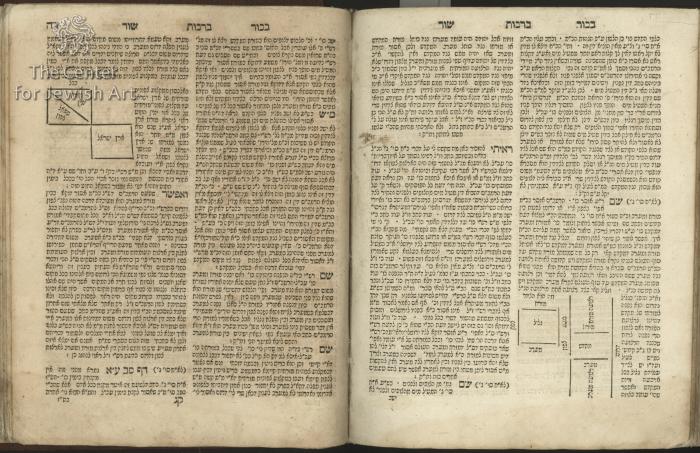Obj. ID: 36412 Tevuot Shor by Alexander Sender ben Ephraim Zalman Schorr, Żółkiew, 1840

sub-set tree:
This text was prepared by William Gross:
Sefer Simlah Chadasha with Rare Illustrated Leaf Printed in Zolkowa in 1840, part of the title page is printed in red ink. There is also a rare, one-sided leaf in the beginning of the sefer with three illustrations connected to the sefer's title and Rabbi Alexander's family name. This added page is not found in most copies. Sefer Simlah Chadasha was embraced by all the Diaspora as the final ruling in regard to the laws of slaughtering and bedikos. The Baal Shem Tov remarked, that the words of the Simlah Chadasha have the power to purify the soul of a shochet ubodek and ensure that no error will result from him. Similarly, the Zohar was quoted saying that the holy powers of the Simlah Chadasha will stand by a shochet ubodek who is well versed in his sefer and save him from erring, and that one who is not well versed cannot receive rabbinic ordination.[2] 236 leaves | 24 cm
The name of this book is a play of words on the name of the author. It is one of three books printed in this volume, all dealing with issues of ritual slaughter and kashrut. The title page is printed with red ink and the page following has three charming illustrations. By the middle of the 19th century, this book had been printed in eight editions from four cities, all in the Hapsburg Empire.There is another book on ritual slaughter by the same author in the Gross Family Collection.
At the close of the 17th century Zolkiew's first Hebrew printing house was established by the well known printer from Amsterdam, Uri Feibush Halevi. From this time, Zolkiew became one of the three centers of Hebrew typography in Poland (Lviv, Kracow and Zolkiew). In the 18th century, Uri Feibush’s heirs split the printing plant between them, so that thereafter the city had two Hebrew language printing shops with eight printing presses. Publications emanating from the Zolkiew printing houses gained a reputation throughout Poland and abroad, and the city became a world center for the printing of kabbalistic books.
At the end of the 18th century Zolkiew’s Hebrew print shops were transferred to Lviv by order of the Austrian government. In 1791, however, Abraham Judah Leob Meyerhoffer set up a printing shop there, which he ran until his death in 1811, whereupon it was taken over by his son Meyer Zeev. In the 1830's-1850's books from the Meyerhoffer press in Zolkiew were issued by Saul Dov Meyerhoffer.




